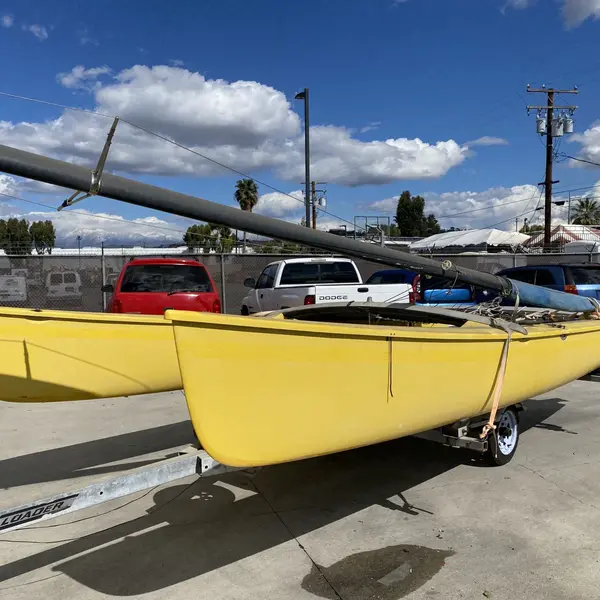Seller's Description
This family friendly classic could be sailed as is, but she would benefit greatly from even a little TLC. If you have been searching for an economical, solid project boat, this is it! This yellow beauty comes with an EZ loader trailer with new tires, a possibly functioning winch, and a large cat box full of extra parts. Extras include a spare front crossbar, a second set of boards, 3 extra rudders, and other useful stuff.A furling jib keeps things manageable even if the breeze suddenly exceeds your comfort level. The retro mainsheet system will make old timers flock to your boat to share stories of their Hobie glory days! Though Mellow Yellow would cut a striking image racing across your local waterway, you might alternatively make a fortune by parting her out to help save other needy Hobie 18s. I had big dreams for this fine boat, but sadly I just don’t have the time to make them come true. She deserves better!
Specs
- Designer
- Hobie Alter
- Builder
- Hobie Cat
- Associations
- ?
- # Built
- ?
- Hull
- Catamaran
- Keel
- Twin Daggerboard
- Rudder
- ?
- Construction
- FG
Dimensions
- Length Overall
- 18′ 0″ / 5.5 m
- Waterline Length
- ?
- Beam
- 8′ 0″ / 2.4 m
- Draft
- 0′ 7″ / 0.2 m — 2′ 5″ / 0.8 m
- Displacement
- 400 lb / 181 kg
- Ballast
- ?
Rig and Sails
- Type
- Sloop
- Reported Sail Area
- 240′² / 22.3 m²
- Total Sail Area
- ?
Mainsail
- Sail Area
- ?
- P
- ?
- E
- ?
- Air Draft
- 27′ 11″ / 8.5 m
Foresail
- Sail Area
- ?
- I
- ?
- J
- ?
- Forestay Length
- ?
Auxilary Power
- Make
- ?
- Model
- ?
- HP
- ?
- Fuel Type
- ?
- Fuel Capacity
- ?
- Engine Hours
- ?
Accomodations
- Water Capacity
- ?
- Holding Tank Capacity
- ?
- Headroom
- ?
- Cabins
- ?
Calculations
- Hull Speed
- ?
Hull Speed
The theoretical maximum speed that a displacement hull can move efficiently through the water is determined by it's waterline length and displacement. It may be unable to reach this speed if the boat is underpowered or heavily loaded, though it may exceed this speed given enough power. Read more.
Formula
Classic hull speed formula:
Hull Speed = 1.34 x √LWL
A more accurate formula devised by Dave Gerr in The Propeller Handbook replaces the Speed/Length ratio constant of 1.34 with a calculation based on the Displacement/Length ratio.
Max Speed/Length ratio = 8.26 ÷ Displacement/Length ratio.311
Hull Speed = Max Speed/Length ratio x √LWL
- Sail Area/Displacement
-
70.9
>20: high performance
Sail Area / Displacement Ratio
A measure of the power of the sails relative to the weight of the boat. The higher the number, the higher the performance, but the harder the boat will be to handle. This ratio is a "non-dimensional" value that facilitates comparisons between boats of different types and sizes. Read more.
Formula
SA/D = SA ÷ (D ÷ 64)2/3
- SA: Sail area in square feet, derived by adding the mainsail area to 100% of the foretriangle area (the lateral area above the deck between the mast and the forestay).
- D: Displacement in pounds.
- Ballast/Displacement
- ?
Ballast / Displacement Ratio
A measure of the stability of a boat's hull that suggests how well a monohull will stand up to its sails. The ballast displacement ratio indicates how much of the weight of a boat is placed for maximum stability against capsizing and is an indicator of stiffness and resistance to capsize.
Formula
Ballast / Displacement * 100
- Displacement/Length
- ?
Displacement / Length Ratio
A measure of the weight of the boat relative to it's length at the waterline. The higher a boat’s D/L ratio, the more easily it will carry a load and the more comfortable its motion will be. The lower a boat's ratio is, the less power it takes to drive the boat to its nominal hull speed or beyond. Read more.
Formula
D/L = (D ÷ 2240) ÷ (0.01 x LWL)³
- D: Displacement of the boat in pounds.
- LWL: Waterline length in feet
- Comfort Ratio
- ?
Comfort Ratio
This ratio assess how quickly and abruptly a boat’s hull reacts to waves in a significant seaway, these being the elements of a boat’s motion most likely to cause seasickness. Read more.
Formula
Comfort ratio = D ÷ (.65 x (.7 LWL + .3 LOA) x Beam1.33)
- D: Displacement of the boat in pounds
- LWL: Waterline length in feet
- LOA: Length overall in feet
- Beam: Width of boat at the widest point in feet
- Capsize Screening
-
4.4
>2.0: better suited for coastal cruising
Capsize Screening Formula
This formula attempts to indicate whether a given boat might be too wide and light to readily right itself after being overturned in extreme conditions. Read more.
Formula
CSV = Beam ÷ ³√(D / 64)
- Beam: Width of boat at the widest point in feet
- D: Displacement of the boat in pounds
This listing is presented by TheBeachCats.com. Visit their website for more information or to contact the seller.





























